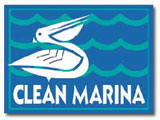Tip #4 – Dealing with exotic plants and sea life while cleaning your boat
Continuing this series developed by the Florida Department of Environmental Protection, we look at the impacts our activities may have on local marine biological communities. Some would ask would I need to worry about this? The quick answer is that these species are either economically important to us (recreational / commercial fin and shellfish), or they impact those species (habitat or food). So we should be aware of our impacts on them.
Invasive plants are those that (1) are non-native to the area, (2) were introduced by humans (whether intentional or not), and (3) are causing an economic or environmental problem. Florida is full of them and a common way they disperse across the state to new bodies of water is boating. They can attach to the propeller or the trailer when launching/recovering your vessel. If you have visited lakes and reservoirs out west you will see signs at the ramp about this issue. Some boat ramps actually have people manning them to look both at your boat and trailer before you launch and after you recover. It is a big problem.
Here, we provide education on best management practices to reduce the chance of spreading these plants.
(1) Boaters should avoid chopping any submerged (or emergent) vegetation with your propeller. Some may be invasive but others could be important natives we wish to protect as well, such as seagrass.
(2) Check your bilge, live wells, and trailers at the ramp before leaving to make sure you are not taking a hitchhiker with you. If you do find, place in an upland trash receptacle and avoid reintroducing.
(3) Flush raw water cooling systems and clean strainers BEFORE launching boats that have been in other bodies of water, or in other states.

Examples of invasive species that have been problematic with boat transfers include: hydrilla, water hyacinth, Eurasian milfoil, and zebra mussels. With a little effort from each captain, we should be able to manage the movement of these problem species and protect our aquatic resources in Florida.
For more information on invasive plants in Florida visit the University of Florida Center for Aquatic and Invasive Plants, http://plants.ifas.ufl.edu/.
 0
0

